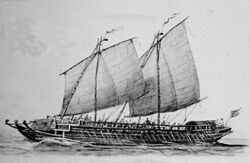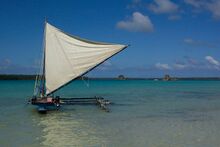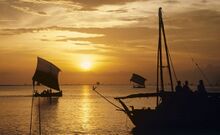Apilan and kota mara
Topic: Engineering
 From HandWiki - Reading time: 6 min
From HandWiki - Reading time: 6 min
Apilan and kota mara are two Malay nautical terms which refers to the structure on a vessel where the cannon is installed. This term is used especially on Malay ships and boats.
Apilan

Apilan (or ampilan)[1]:354 is the wooden gunshield found in Malay prahus where cannons are placed. It has a hole to place long gun, and sometimes swivel gun can be placed over the top of the apilan. Apilan is not permanent, it can be assembled, disassembled, and moved.[2] The crew of Malay prahu operated the long gun behind an apilan. The apilan usually situated at the bow of a prahu.[3] This gun-shield was only put on when the ship went into action. Sunting apilan is the name given to two lelas or light guns standing on the gun-shield of a heavy gun.[4]
Etymology
Apilan is a true Malay word, it was not descended from any word. It is also a standalone word, due to the fact that the syllable is api-lan instead of apil-an.[5]
Kota mara

Kota mara is the breastwork or casement of Malay prahus. The function is to protect the gunner. Contrary to apilan, the kota mara cannot be moved.[2] It is the permanent bulwark of the battery in a Malay piratical ship. The term saga kota mara refers to a peculiar props keeping the gun shield (apilan) in position. The word benteng is also used for this permanent breastwork. Ambong-ambong are blocks of wood forming part of the framework of the battery in a Malay piratical perahu. These blocks support the base of the benteng.[4] The kota mara is already existed since at least the 8th century A.D., being shown in Borobudur ship bas relief.[6]
Etymology
The term comes from Malay word kota which in turn comes from the Sanskrit word कोट्ट (kota) which means fort, fortress, castle, fortified house, fortification, works, city, town, or place encircled by walls.[7] The word mara may come from Malay word meaning "appear before", "forward", "come",[5] "moved to the front", "forward", and "advanced".[8] Thus it can be interpreted as "breastwork before a cannon" or "breastwork at the front". According to the Great Indonesian Dictionary (KBBI), kota mara means (1) Wall on a ship to protect men mounting the cannon (2) Terrace or wall over a castle which a cannon is mounted.[5] According to H. Warington Smyth, kota mara means transverse deck bulkhead at stem and stern (of a ship).[9] Benteng itself means fort, battery, or redoubt.[4]
Example on records
Singapore resident John Crawfurd recorded Malay piracy near Singapore waters. The Malay pirate ships of the time were 40–50 feet (12–15 m) long with 15-foot (4.6 m) beam. The decks were made of split nibong wood. Smaller pirate craft put up thick plank bulwarks [apilan] when fighting, while larger ones like those of the Lanun people had bamboo ledges hanging over their gunwales, with a protecting breastwork [kota mara] of plaited rattan about 3 feet (0.91 meters) high. A crew might consist of 20–30 men, augmented with oarsmen of captured slaves. Small craft would have nine oars per side; larger ones would be double-banked, with an upper tier of oarsmen seated on the bulwark projection hidden behind rattan breastwork. Pirate armament included a stockade near the bow, with iron or brass 4-pounders, and another stockade aft, generally with two swivel guns. They also might have four or five brass swivels, or rantaka, on each side. They have bamboo shields, and were armed with spears, keris, muskets and other firearms they could get.[10]
H. H. Frese description of personal ship of the Sultan of Riau from 1883:[11]
This fast and impressive ship is heavily armed to fend off pirates, a real danger at that time. Two heavy muzzle-loading brass guns mounted on carriages are placed on the foredeck pointing forward. A heavy shield, or apilan, for the protection of the gunners, is constructed of horizontal beams for which fresh wood had to be used to prevent dangerous splintering when hit by a ball or bullet.
Lieutenant T.J. Newbold record about the Malay pirate prahu:[3]
The prahus used by Malay pirates are from eight to ten tons burthen, extremely well manned and remarkably fast, particularly with the paddles commonly used. They are generally armed with swivels on their bows, centre, and stern, of small calibre, but long range. When preparing to attack, strong bulwarks of wood called Apilans are erected, behind which the crew ensconce themselves, fighting with their long guns until their prey is disabled; or till the gong sound the signal for boarding.
See also
- Jong – Javanese sailing ship
- Engineering:Malangbang – Indonesian medieval sailing ship
- Engineering:Kotta mara – Floating fort from Borneo
- Engineering:Lanong – Type of warship from the Philippines
- Engineering:Bajak
- Engineering:Salisipan
References
- ↑ Crawfurd, John (1856). A Descriptive Dictionary of the Indian Islands and Adjacent Countries. Bradbury and Evans.
- ↑ 2.0 2.1 Wilkinson, Richard James (1908). An Abridged Malay-English Dictionary (Romanised). Kuala Lumpur: F.M.S Government Press.
- ↑ 3.0 3.1 Newbold, T.J. (1836). "Note on the States of Perak, Srimenanti, and other States in the Malay Peninsula". Journal of the Asiatic Society of Bengal 5.
- ↑ 4.0 4.1 4.2 Wilkinson, Richard James (1901). A Malay-English dictionary. Hongkong: Kelly & Walsh, limited.
 This article incorporates text from this source, which is in the public domain.
This article incorporates text from this source, which is in the public domain.
- ↑ 5.0 5.1 5.2 Departemen Pendidikan Nasional (2008). Kamus Besar Bahasa Indonesia Pusat Bahasa Edisi Keempat. Jakarta: PT Gramedia Pustaka Utama.
- ↑ Liebner, Horst (in id). 2016 Gambar Dan Tabel Perahu MSI short1.pdf. https://www.academia.edu/29803276.
- ↑ Siegel, James T. (2018). Southeast Asia over Three Generations: Essays Presented to Benedict R. O'G. Anderson. New York: Cornell University Press. pp. 94. ISBN 9781501718946.
- ↑ "MARA - Definition and synonyms of mara in the Malay dictionary" (in en). https://educalingo.com/en/dic-ms/mara.
- ↑ Smyth, H. Warington (May 16, 1902). "Boats and Boat Building in the Malay Peninsula". Journal of the Society of Arts 50: 570–588.
- ↑ Murfett, Malcolm H. (2011). Between 2 Oceans (2nd Edn): A Military History of Singapore from 1275 to 1971. Marshall Cavendish International Asia Pte Ltd.
- ↑ H. H. Frese. (1956). Small Craft in the Rijksmuseum voor Volkenkunde, Leiden. The Mariner's Mirror. 42 : 2, 101-112.
 |
 KSF
KSF





